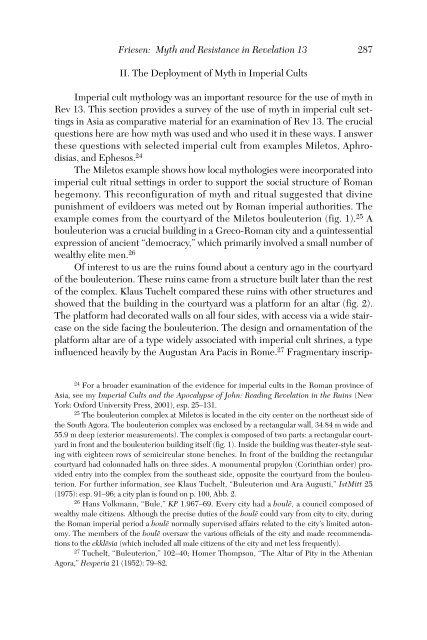Journal of Biblical Literature - Society of Biblical Literature
Journal of Biblical Literature - Society of Biblical Literature
Journal of Biblical Literature - Society of Biblical Literature
You also want an ePaper? Increase the reach of your titles
YUMPU automatically turns print PDFs into web optimized ePapers that Google loves.
Friesen: Myth and Resistance in Revelation 13 287<br />
II. The Deployment <strong>of</strong> Myth in Imperial Cults<br />
Imperial cult mythology was an important resource for the use <strong>of</strong> myth in<br />
Rev 13. This section provides a survey <strong>of</strong> the use <strong>of</strong> myth in imperial cult settings<br />
in Asia as comparative material for an examination <strong>of</strong> Rev 13. The crucial<br />
questions here are how myth was used and who used it in these ways. I answer<br />
these questions with selected imperial cult from examples Miletos, Aphrodisias,<br />
and Ephesos. 24<br />
The Miletos example shows how local mythologies were incorporated into<br />
imperial cult ritual settings in order to support the social structure <strong>of</strong> Roman<br />
hegemony. This reconfiguration <strong>of</strong> myth and ritual suggested that divine<br />
punishment <strong>of</strong> evildoers was meted out by Roman imperial authorities. The<br />
example comes from the courtyard <strong>of</strong> the Miletos bouleuterion (fig. 1). 25 A<br />
bouleuterion was a crucial building in a Greco-Roman city and a quintessential<br />
expression <strong>of</strong> ancient “democracy,” which primarily involved a small number <strong>of</strong><br />
wealthy elite men. 26<br />
Of interest to us are the ruins found about a century ago in the courtyard<br />
<strong>of</strong> the bouleuterion. These ruins came from a structure built later than the rest<br />
<strong>of</strong> the complex. Klaus Tuchelt compared these ruins with other structures and<br />
showed that the building in the courtyard was a platform for an altar (fig. 2).<br />
The platform had decorated walls on all four sides, with access via a wide staircase<br />
on the side facing the bouleuterion. The design and ornamentation <strong>of</strong> the<br />
platform altar are <strong>of</strong> a type widely associated with imperial cult shrines, a type<br />
influenced heavily by the Augustan Ara Pacis in Rome. 27 Fragmentary inscrip-<br />
24 For a broader examination <strong>of</strong> the evidence for imperial cults in the Roman province <strong>of</strong><br />
Asia, see my Imperial Cults and the Apocalypse <strong>of</strong> John: Reading Revelation in the Ruins (New<br />
York: Oxford University Press, 2001), esp. 25–131.<br />
25 The bouleuterion complex at Miletos is located in the city center on the northeast side <strong>of</strong><br />
the South Agora. The bouleuterion complex was enclosed by a rectangular wall, 34.84 m wide and<br />
55.9 m deep (exterior measurements). The complex is composed <strong>of</strong> two parts: a rectangular courtyard<br />
in front and the bouleuterion building itself (fig. 1). Inside the building was theater-style seating<br />
with eighteen rows <strong>of</strong> semicircular stone benches. In front <strong>of</strong> the building the rectangular<br />
courtyard had colonnaded halls on three sides. A monumental propylon (Corinthian order) provided<br />
entry into the complex from the southeast side, opposite the courtyard from the bouleuterion.<br />
For further information, see Klaus Tuchelt, “Buleuterion und Ara Augusti,” IstMitt 25<br />
(1975): esp. 91–96; a city plan is found on p. 100, Abb. 2.<br />
26 Hans Volkmann, “Bule,” KP 1.967–69. Every city had a bouleµ, a council composed <strong>of</strong><br />
wealthy male citizens. Although the precise duties <strong>of</strong> the bouleµ could vary from city to city, during<br />
the Roman imperial period a bouleµ normally supervised affairs related to the city’s limited autonomy.<br />
The members <strong>of</strong> the bouleµ oversaw the various <strong>of</strong>ficials <strong>of</strong> the city and made recommendations<br />
to the ekkleµsia (which included all male citizens <strong>of</strong> the city and met less frequently).<br />
27 Tuchelt, “Buleuterion,” 102–40; Homer Thompson, “The Altar <strong>of</strong> Pity in the Athenian<br />
Agora,” Hesperia 21 (1952): 79–82.

















